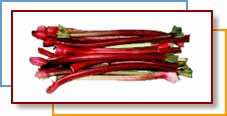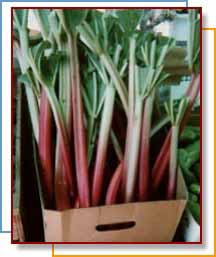
Rhubarb is a relative of buckwheat and has an earthy, sour flavor.
Rhubarb thrives in cold climates and originated in Western China, Tibet,
Mongolia, Siberia and neighboring areas. The traditional role was
medicinal-the dried root was a popular remedy for a wide range of illnesses.
Its primary function was to induce vomiting, although rhubarb is also a
mild astringent. This medicinal role caused the price of the dried root to
rise. In 1542, rhubarb sold for ten times the price of cinnamon in France
and in 1657 rhubarb sold for over twice the price of opium in England
(Schneider, 2001). Beginning in the eighteenth century, rhubarb began to
be consumed in foods, primarily drinks and meat stews.
Botanically speaking, rhubarb is considered a vegetable, but it's most
often treated as a fruit — though it's rarely eaten raw. Just like fresh
cranberries, rhubarb is almost unbearably tart on its own and needs the
sweetness of sugar, honey, or fruit juice added to it to balance out the
acidity. Rhubarb's nickname is the "pie plant" because that is the primary
use for this vegetable.
Rhubarb was introduced to the United States at the end of the eighteenth
century. Today most rhubarb is frozen for commercial and institutional
use; only about a quarter of the crop is sold fresh.
| |
|
Rhubarb |
Serving Size
½ cup diced (61g)
|
Amounts
Per Serving |
% Daily
Value |
| Calories
15 |
|
| Calories
from Fat 0 |
|
| Total Fat 0g |
0% |
| Saturated
Fat 0g |
0% |
|
Sodium 0 |
0% |
| Cholesterol
0mg |
0% |
| Total
Carbohydrate 3g |
1% |
|
Dietary Fiber 1g |
4% |
|
Sugars 1g |
|
| Protein
1g |
|
| Vitamin A |
2% |
| Vitamin C |
8% |
| Calcium |
6% |
| Iron |
0% |
* Percent Daily Values are based on a
2,000 calorie diet.
|
|
| |
|
Hothouse, or strawberry, rhubarb appears in markets as early as January
and continues to be stocked through April. Field-grown, or cherry, rhubarb
begins to arrive in markets in March and can continue to arrive through
the summer (depending on the area where it is grown). Spring stalks are
the juiciest and most-tender.
Fresh stalks are flat, not curled or limp. When stalks that have been
pulled-not cut-from the field are available; choose them. Pulled stalks
dry out less rapidly. Size is no indicator of tenderness. Deep red stalks
are sweeter and richer.
Wrap rhubarb in plastic wrap and store it in the coldest part of the
refrigerator for up to one week. Cooked and raw rhubarb both freeze well.
Cut off and discard and leaves (see warning). Rinse and trim from base
and tip. You may peel or cut with the skin intact. Remember to cook only
in non-aluminum pots only due to the acidic nature of rhubarb.
WARNING
Never eat rhubarb leaves, cooked or raw. Eating the leaves can be
poisonous because they contain oxalate. This toxin, plus another
unknown toxin also found in the leaves, has been reported to cause
poisoning when large quantities of raw or cooked leaves are ingested. |
 Red stalk types: Crimson (may also be called Crimson
Cherry, Crimson Red, or Crimson Wine). It produces brightly colored red
stalks with the unique characteristic of being red throughout under normal
temperature and moisture conditions of the Pacific Northwest. Other
vigorous red varieties are Valentine and Cherry Red (Cherry, Early
Cherry), producing long, thick, deep-red stalks. Red stalk types: Crimson (may also be called Crimson
Cherry, Crimson Red, or Crimson Wine). It produces brightly colored red
stalks with the unique characteristic of being red throughout under normal
temperature and moisture conditions of the Pacific Northwest. Other
vigorous red varieties are Valentine and Cherry Red (Cherry, Early
Cherry), producing long, thick, deep-red stalks.
 Speckled types (pink): Victoria produces large stalks of excellent
quality, long, round with smooth ribs. It develops pink speckling on a
light green stalk with the pink color being more intense at the bottom of
the stalk, fading to a solid green near the top. Victoria is commonly used
for forcing. Speckled types (pink): Victoria produces large stalks of excellent
quality, long, round with smooth ribs. It develops pink speckling on a
light green stalk with the pink color being more intense at the bottom of
the stalk, fading to a solid green near the top. Victoria is commonly used
for forcing.
Strawberry is very similar to Victoria, and may be the same variety.
MacDonald is another "pink" type that produces well.
German Wine is similar to Victoria but slightly more vigorous and more
intense in color, typically with a darker pink speckling on a green stem.
Green varieties: Riverside Giant, a cold-hardy, vigorous
producer with large diameter, long, green stalks.

Recipes
Baked Rhubarb with Raspberries
Serves 4
Each serving equals 1 cup of fruit or vegetables
Ingredients
1 1/3 cups raspberries (about 6 ounces)
¾ cup firmly packed light brown sugar
1/4 cup very hot water
2 Tbsp unsalted butter, cut into bits
¼ tsp vanilla
1 pound rhubarb, trimmed and cut into ½-inch pieces (about 4 cups)
8 small scoops of low-fat frozen yogurt
Preheat the oven to 350°F. In a blender purée the raspberries with the
brown sugar and the water, strain the purée through a sieve into a bowl,
pressing hard on the solids, and stir in the butter, the vanilla, and the
rhubarb. Transfer the mixture to an 11- by 7-inch baking dish and bake the
dessert in the middle of the oven, for a total of 30 minutes, stir once
very gently after 15 minutes. Cook until the rhubarb is soft. Let the
dessert cool for 10 minutes and serve it over frozen low-fat yogurt.
Nutritional analysis per serving: Calories 372, Fat 6g,
Calories from Fat 13%, Protein 5g, Cholesterol 12mg, Sodium
141g.
Find more in our
recipe database!
|



